10-11学年高中英语课时讲练通课件:Unit2《Wish you were here》Period5(译林牛津版必修2)
文档属性
| 名称 | 10-11学年高中英语课时讲练通课件:Unit2《Wish you were here》Period5(译林牛津版必修2) |  | |
| 格式 | rar | ||
| 文件大小 | 5.0MB | ||
| 资源类型 | 教案 | ||
| 版本资源 | 牛津译林版 | ||
| 科目 | 英语 | ||
| 更新时间 | 2011-11-06 16:47:45 | ||
图片预览

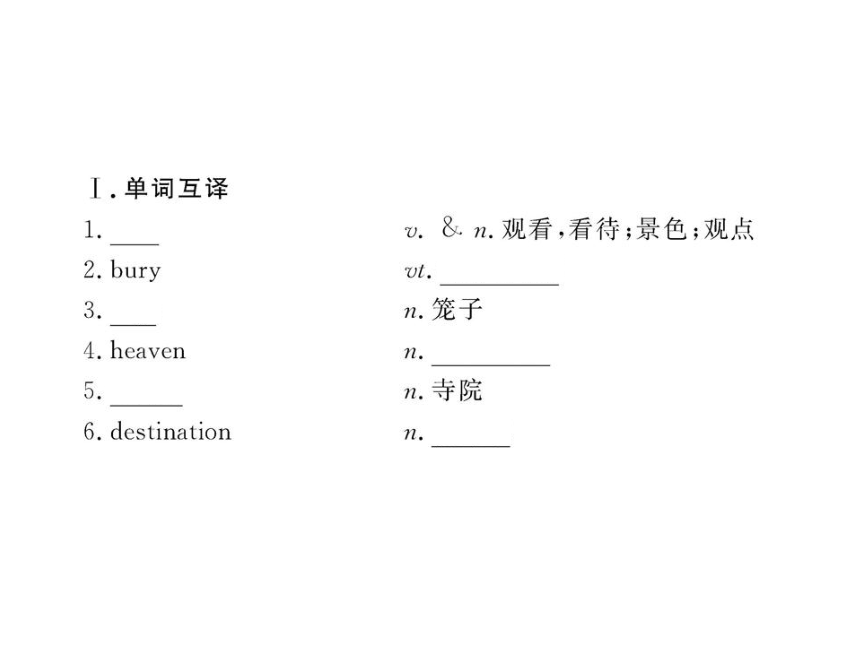
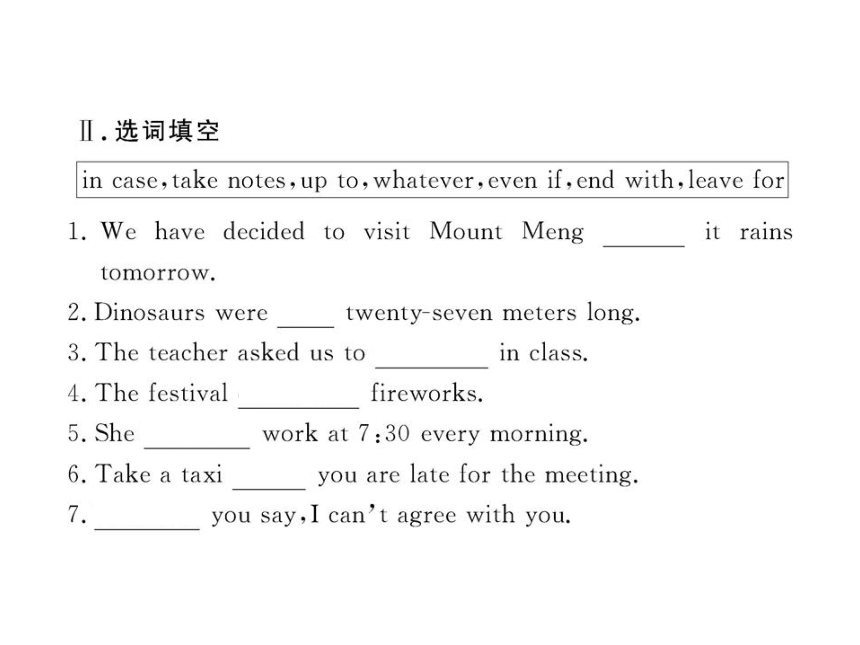


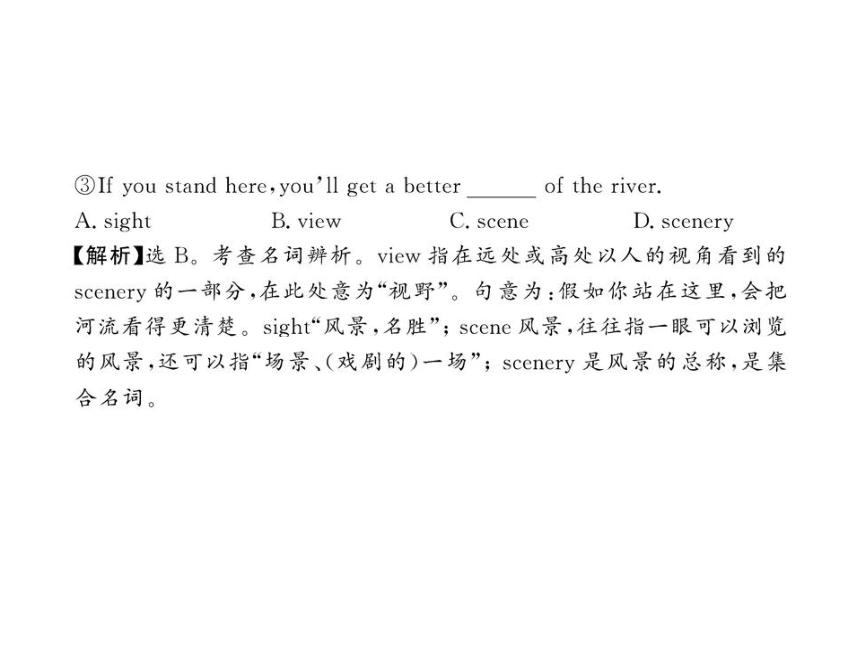

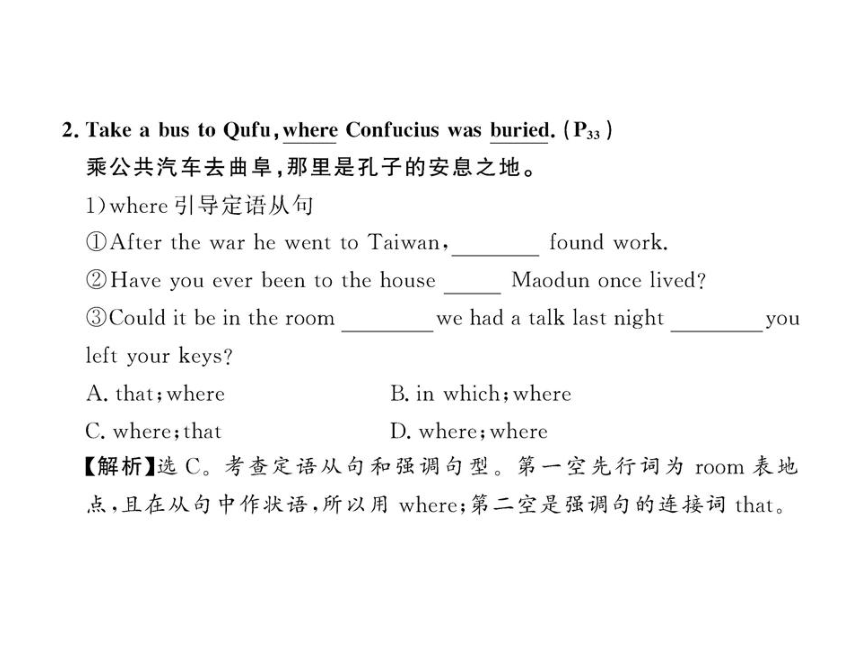

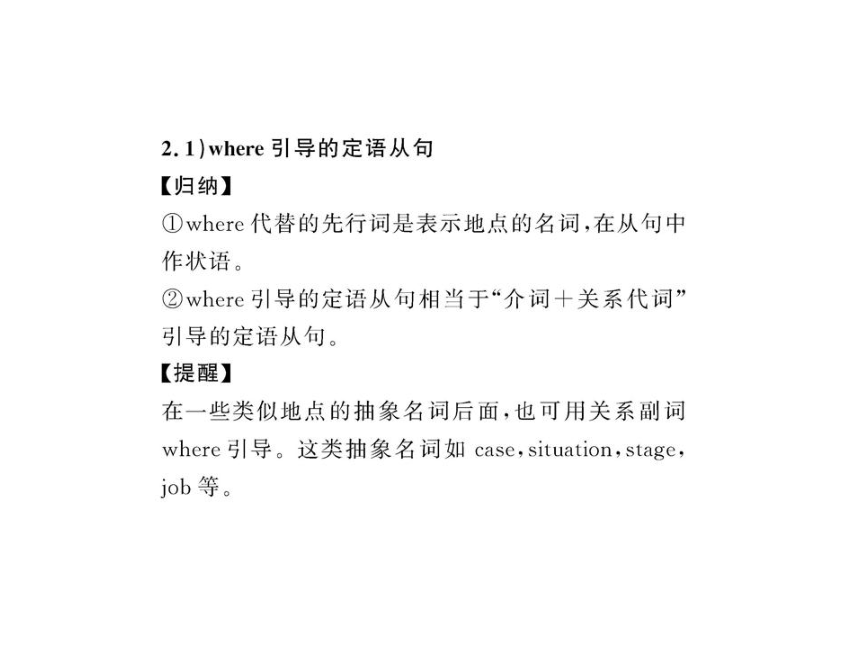

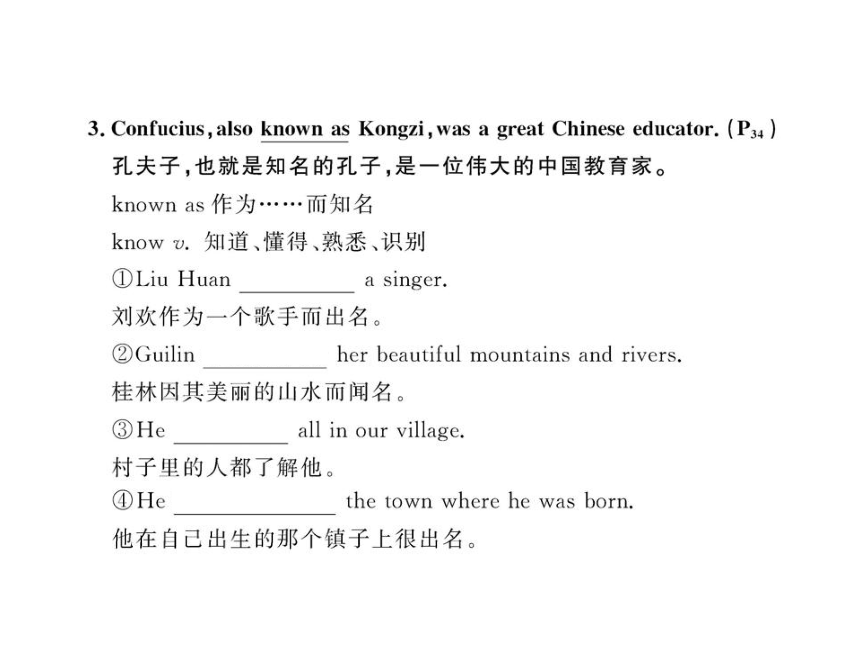
文档简介
(共47张PPT)
Ⅰ. 完成句子
1. This afternoon I’ll stay at home in case (以防,万一) my friend visits me.
2. The professor told his students to take notes (记笔记) carefully.
3. It’s not right that parents give their children whatever (凡是……的东西) they want.
4. He was sitting with his head buried (埋) in a book.
5. Now China is paying great attention to (非常注意) developing its economy.
Ⅱ. 单项填空
1. Don’t _____ women. They are as important as men for the development of society.
A. look up to B. look down upon
C. look out for D. look forward to
【解析】选B。考查动词短语。look up to尊敬;look down upon轻视,瞧不起;look out for留心,提防;look forward to盼望,期待。句意:别瞧不起妇女,她们在对社会的发展方面和男人一样重要。
2. When the teacher asks you questions in class, you’d better not keep _____ .
A. quiet B. still C. silent D. calm
【解析】选C。silent不出声;quiet指环境安静;still静止的,不动的;calm镇静。
3. _____ in the interesting story, the girl didn’t notice that all her classmates have all gone away.
[2010厦门高一检测]
A. Buried B. Burying C. To bury D. Bury
【解析】选A。考查分词作状语和bury的用法。be buried in固定词组,沉思,埋头于……。此处表状态。如用B项,则为burying herself in结构。
4. From the top of Mount Tai, you can get a particular wonderful _____ of sunrise.
[2010济宁高一检测]
A. scenery B. sight C. view D. scene
【解析】选C。scenery指一个国家或某一地区的整体自然风景,为不可数名词。sight 侧重指旅游观光的风光,包括城市景色或自然风光景色。也指人造景物或奇特的景色。view是可数名词, 多指从远处或高处或从一个点所见的景色。scene指具体的、局部的或一时的景色,可以是自然形成的,也可以是人工造成的。
5. He wrote a long moving poem in memory of Qian Xuesen who is _____ “Father of Chinese Rocketry”.
A. known for B. known to
C. known as D. knowing about
【解析】选C。be known as作为……而知名;known for因……著名;known to为……所熟悉;know about了解。
6. We will never forget the days _____ we spent _____ those old men and women in the home for the aged.
[2010福州高一检测]
A. which; helping B. when; to help
C. during which; helping D. that; help
【解析】选A。考查定语从句。第一空所缺部分作spend的宾语,可以用which或that; 第二空考查了“spend. . . (in) doing sth. ”的结构,选helping。
7. On television last night the newscaster announced that the leader _____ on Saturday.
A. is arriving B. will arrive
C. would be arrived D. would arrive
【解析】选D。考查过去将来时。从句中时间看是昨天晚上,但arrive这一动作发生在昨天晚上之后,所以用过去将来时。
8. —Can you believe I had to pay 30 dollars for a haircut
—You should try the barber’s _____ I go. It’s only 15.
[2010天津高考]
A. as B. which C. where D. that
【解析】选C。句意:——你能相信我花了30美元理发吗?——你应该试一试我去的理发店,只花15美元。根据题干the barber’s在I go这个定语从句中作地点状语,go是不及物动词。where在定语从句中作地点状语。其他几个选项作的是主语、宾语和表语。所以选C。
Ⅲ. 书面表达
[2010天津高一检测]
假设你叫李华, 你的朋友Joan即将到你班来学习。来之前她想了解班主任李老师的一些情况。请你给她发一封英文e-mail, 介绍李老师的情况。内容要点如下:
1. 李老师年近四十,1994年任教以来,工作一贯努力,曾多次受到表扬。
2. 他知识丰富,教学有方,上课生动有趣,学生爱听他的课。
3. 他与学生关系融洽,对学生要求严格。经常鼓励大家勤奋学习。在他的帮助之下,大家进步很快。
注意:你的电子信箱是:lihua@; Joan的电子信箱是:Joan@washington. com。
词数: 100左右。
【参考范文】
发件人 lihua@
收件人Joan@washington. com
主题 Our teacher
Dear Joan,
Our teacher, Mr. Li, is now nearly forty years old. He came to our school in 1994. All these years he has been working very hard, and is strict in his work. He has been praised for his good work many times.
He has much knowledge and has strange ways of making his lessons lively and interesting. All of us enjoy his lessons.
What’s more, he is getting on well with us, but he is very strict with us. He often encourages us to study hard. With his help, we’ve made much progress.
Mr. Li is not only our good teacher, but also our good friend. We all love and respect him.
Yours,
Li Hua
Even a child knows that nodding(点头) the head means “Yes”. But some people will probably be puzzled when they first come to India. When they talk to an Indian, he often shakes his head. They might think that the Indian does not like what he said, but on the contrary he is expressing agreement.
The Indians have a habit of shaking their heads slightly when they talk to somebody. It doesn’t mean “No”, but “Yes”.
If a person doesn’t know this, it might cause misunderstanding.
At one time,a foreigner in India told his driver who was an Indian to take him to his office. The driver shook his head. The foreigner repeated his request and the driver shook his head again. At last, the foreigner shouted angrily, “Drive me to my office at once! ”The driver said in a low voice, “Yes, sir”, smiling and shaking his head again at the same time.
本文介绍肢体语言在不同国家所表达的不同含义。
1. Generally speaking, nodding the head means _____ , and shaking the head means _____ .
A. Yes; No B. No;Yes
C. Yes; Yes D. No; No
【解析】选A。第一段第一句话说“即便一个小孩都明白点头表示yes”,由此可知答案为A。
2. According to the habit of India, if someone agrees with you, he will _____ .
A. nod his head
B. shake his head
C. neither nod his head nor shake his head
D. either nod his head or shake his head
【解析】选B。据第二段可推知答案为B。
3. Why did the Indian driver shake his head when the foreigner asked him to drive him to his office Because _____ .
A. the Indian driver had something important to do
B. the foreigner promised to give him only a little money
C. the driver felt uncomfortable at that time
D. in India, shaking the head means agreement
【解析】选D。在印度, 摇头表示同意。因此选择D项。
4. Why did the foreigner become angry Because _____ .
A. the Indian driver didn’t want to send him to his office
B. he misunderstood the meaning of shaking the head in India
C. he asked the driver to send him to his office, but the Indian driver didn’t say any words
D. the Indian driver asked him for a lot of money
【解析】选B。根据第三段 If a person doesn’t know this, it might cause misunderstanding可知答案为B。
5. The phrase “on the contrary” means _____ .
A. just the opposite
B. clear difference between two things
C. doing what you want to do
D. on the other hand
【解析】选A。由 on the contrary之前的 but可知,后面的内容与前面的内容相反,故选A。
Ⅰ. 完成句子
1. This afternoon I’ll stay at home in case (以防,万一) my friend visits me.
2. The professor told his students to take notes (记笔记) carefully.
3. It’s not right that parents give their children whatever (凡是……的东西) they want.
4. He was sitting with his head buried (埋) in a book.
5. Now China is paying great attention to (非常注意) developing its economy.
Ⅱ. 单项填空
1. Don’t _____ women. They are as important as men for the development of society.
A. look up to B. look down upon
C. look out for D. look forward to
【解析】选B。考查动词短语。look up to尊敬;look down upon轻视,瞧不起;look out for留心,提防;look forward to盼望,期待。句意:别瞧不起妇女,她们在对社会的发展方面和男人一样重要。
2. When the teacher asks you questions in class, you’d better not keep _____ .
A. quiet B. still C. silent D. calm
【解析】选C。silent不出声;quiet指环境安静;still静止的,不动的;calm镇静。
3. _____ in the interesting story, the girl didn’t notice that all her classmates have all gone away.
[2010厦门高一检测]
A. Buried B. Burying C. To bury D. Bury
【解析】选A。考查分词作状语和bury的用法。be buried in固定词组,沉思,埋头于……。此处表状态。如用B项,则为burying herself in结构。
4. From the top of Mount Tai, you can get a particular wonderful _____ of sunrise.
[2010济宁高一检测]
A. scenery B. sight C. view D. scene
【解析】选C。scenery指一个国家或某一地区的整体自然风景,为不可数名词。sight 侧重指旅游观光的风光,包括城市景色或自然风光景色。也指人造景物或奇特的景色。view是可数名词, 多指从远处或高处或从一个点所见的景色。scene指具体的、局部的或一时的景色,可以是自然形成的,也可以是人工造成的。
5. He wrote a long moving poem in memory of Qian Xuesen who is _____ “Father of Chinese Rocketry”.
A. known for B. known to
C. known as D. knowing about
【解析】选C。be known as作为……而知名;known for因……著名;known to为……所熟悉;know about了解。
6. We will never forget the days _____ we spent _____ those old men and women in the home for the aged.
[2010福州高一检测]
A. which; helping B. when; to help
C. during which; helping D. that; help
【解析】选A。考查定语从句。第一空所缺部分作spend的宾语,可以用which或that; 第二空考查了“spend. . . (in) doing sth. ”的结构,选helping。
7. On television last night the newscaster announced that the leader _____ on Saturday.
A. is arriving B. will arrive
C. would be arrived D. would arrive
【解析】选D。考查过去将来时。从句中时间看是昨天晚上,但arrive这一动作发生在昨天晚上之后,所以用过去将来时。
8. —Can you believe I had to pay 30 dollars for a haircut
—You should try the barber’s _____ I go. It’s only 15.
[2010天津高考]
A. as B. which C. where D. that
【解析】选C。句意:——你能相信我花了30美元理发吗?——你应该试一试我去的理发店,只花15美元。根据题干the barber’s在I go这个定语从句中作地点状语,go是不及物动词。where在定语从句中作地点状语。其他几个选项作的是主语、宾语和表语。所以选C。
Ⅲ. 书面表达
[2010天津高一检测]
假设你叫李华, 你的朋友Joan即将到你班来学习。来之前她想了解班主任李老师的一些情况。请你给她发一封英文e-mail, 介绍李老师的情况。内容要点如下:
1. 李老师年近四十,1994年任教以来,工作一贯努力,曾多次受到表扬。
2. 他知识丰富,教学有方,上课生动有趣,学生爱听他的课。
3. 他与学生关系融洽,对学生要求严格。经常鼓励大家勤奋学习。在他的帮助之下,大家进步很快。
注意:你的电子信箱是:lihua@; Joan的电子信箱是:Joan@washington. com。
词数: 100左右。
【参考范文】
发件人 lihua@
收件人Joan@washington. com
主题 Our teacher
Dear Joan,
Our teacher, Mr. Li, is now nearly forty years old. He came to our school in 1994. All these years he has been working very hard, and is strict in his work. He has been praised for his good work many times.
He has much knowledge and has strange ways of making his lessons lively and interesting. All of us enjoy his lessons.
What’s more, he is getting on well with us, but he is very strict with us. He often encourages us to study hard. With his help, we’ve made much progress.
Mr. Li is not only our good teacher, but also our good friend. We all love and respect him.
Yours,
Li Hua
Even a child knows that nodding(点头) the head means “Yes”. But some people will probably be puzzled when they first come to India. When they talk to an Indian, he often shakes his head. They might think that the Indian does not like what he said, but on the contrary he is expressing agreement.
The Indians have a habit of shaking their heads slightly when they talk to somebody. It doesn’t mean “No”, but “Yes”.
If a person doesn’t know this, it might cause misunderstanding.
At one time,a foreigner in India told his driver who was an Indian to take him to his office. The driver shook his head. The foreigner repeated his request and the driver shook his head again. At last, the foreigner shouted angrily, “Drive me to my office at once! ”The driver said in a low voice, “Yes, sir”, smiling and shaking his head again at the same time.
本文介绍肢体语言在不同国家所表达的不同含义。
1. Generally speaking, nodding the head means _____ , and shaking the head means _____ .
A. Yes; No B. No;Yes
C. Yes; Yes D. No; No
【解析】选A。第一段第一句话说“即便一个小孩都明白点头表示yes”,由此可知答案为A。
2. According to the habit of India, if someone agrees with you, he will _____ .
A. nod his head
B. shake his head
C. neither nod his head nor shake his head
D. either nod his head or shake his head
【解析】选B。据第二段可推知答案为B。
3. Why did the Indian driver shake his head when the foreigner asked him to drive him to his office Because _____ .
A. the Indian driver had something important to do
B. the foreigner promised to give him only a little money
C. the driver felt uncomfortable at that time
D. in India, shaking the head means agreement
【解析】选D。在印度, 摇头表示同意。因此选择D项。
4. Why did the foreigner become angry Because _____ .
A. the Indian driver didn’t want to send him to his office
B. he misunderstood the meaning of shaking the head in India
C. he asked the driver to send him to his office, but the Indian driver didn’t say any words
D. the Indian driver asked him for a lot of money
【解析】选B。根据第三段 If a person doesn’t know this, it might cause misunderstanding可知答案为B。
5. The phrase “on the contrary” means _____ .
A. just the opposite
B. clear difference between two things
C. doing what you want to do
D. on the other hand
【解析】选A。由 on the contrary之前的 but可知,后面的内容与前面的内容相反,故选A。
